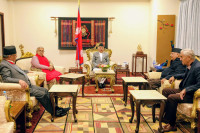Opinion
Pains of motherhood
Just 35km from the Capital, in Lalitpur, health posts are in dismal conditions
Shradha Giri Bohara
After contemplating the dismal standards of Nepal’s health posts in the Far West for months, I decided to check on health posts around the Kathmandu Valley to help me better understand the situation and make a relative comparison. Situated only 35km from the Capital, the health posts in Sankhu, Bhattedanda and Pyutar of Lalitpur were neglected to such an extent that it was disturbing for me to fathom the distance from the Capital. The birthing centres housed in the health posts lacked the minimum health standards set by the government and the health posts overall were highly understaffed.
At Sankhu
The road to Sankhu, Bhattedanda and Pyutar is motorable but hold your breath if you are driving to these places for the first time—the ride is definitely not for the fainthearted. The health post in Sankhu is a three-room structure—one room dedicated for birthing with just one iron bed and nothing else in sight. The other two rooms are used to store medicines and supplies and for general checkups. One of my colleagues mentioned that Baitadi’s health post is comparatively better. But Baitadi is remote and isn’t this is Lalitpur, I reasoned?
Although the health post had basic supplies such as oxygen and suction pumps necessary to resuscitate newborns, the supplies were collecting dust due to a lack of skilled birth attendants trained to use these supplies. Expecting mothers prefer to give birth at home because the health post is worse off in terms of comfort and a lack of skilled birth attendants—a staggering 60 percent of expecting mothers give birth at home.
It is only when complications arise after birth or during labour that new mothers are referred to hospitals. The nearest one is a five-hour walk away and with no stretcher or ambulance, the trauma these expecting mothers face must be unbearable.
Bhattedanda and Pyutar
The birthing centre in Bhattedanda was in a better condition because it hosted a doctor and a couple of skilled birth attendants. This health post operates 24 hours a day as it receives patients from many adjoining areas. However, the post is at a distance of a roughly three-five-hour walk distance for the majority.
“This is a place for patients, who come with hope, but the treatment here is primary care and if complications arise we do a lot of referral,” said Rajkumar Sapkota, health post in-charge.
The health post in Pyutar was the worst among the three. Despite the fact that around 700 patients visit the health post during the peak of summer, there is not a single health assistant to provide medical care. The absence of health assistants and skilled birth attendants means the only reason patients visit the health post is due to the sheer will of the staff to serve. The birthing centre only has one room. This means mothers have to give birth and go home immediately. Sadly, new mothers are expected to walk for hours immediately after giving birth.
“Most births take place at night. Since there is no inverter, I always deliver babies with the help of my torchlight. Many times, I have to hold the torch with one hand and deliver a baby with the other because there is no one else,” said Saraswati Timilsina, auxiliary nurse midwife. “We don’t even have a stretcher and sometimes even though the mother may benefit by coming to the health post, the lack of stretcher means that they end up giving birth at home.”
Saraswati also mentioned that the 10 stretchers had been allocated for each VDC but that they had been waiting for the stretchers to show up for some time. The health post does not have an ambulance and the sick are expected to walk for hours to reach the nearest hospital.
Hope for one
There is hope for Bhattedanda as the government is building a model health post there. But it will be a long wait for Sankhu and Pyutar. The government will only build a model health post in all VDCs (one each) if the VDCs can provide land—minimum three ropanis. The health post in Pyutar can be relocated anywhere at any time as the land is not registered under the health post.
This visit shed light on the dismal conditions of health posts and birthing centres so close to the Capital. A staggering 60 percent of expecting mothers are giving birth at home just 35 km away from the Capital and the fact that is there are hundreds of health posts in worse condition, waiting to be upgraded and supported with skilled human resource. Nepal still has a long way to go because no mother should have to die giving birth.
Giri Bohara is Communication Coordinator at Save the Children




 14.12°C Kathmandu
14.12°C Kathmandu











